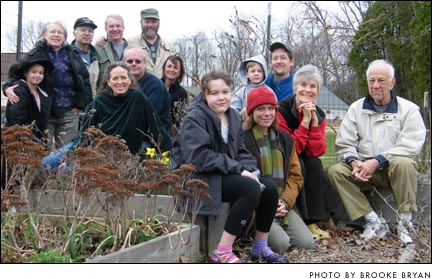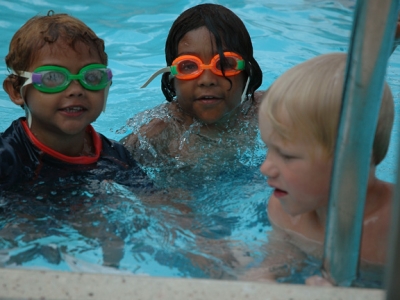
Some members of the loosely-networked community gardening group are shown in the FCC garden. Pictured from left to right are: standing, back row: Meranda Pelzl, Corinne Pelzl, Daniel L. Pelzl, Rob Content and Doug ‘Thor’ Bailey. Middle row, seated: Faith Morgan, Eric Johnson, Jenny Haack, Max Banaszak-Moore, Bob Moore. Front row: McKenna Banaszak-Moore and Christine O. Roberts, Sally Palmer and Paul Webb.
Gardens yield more than green
- Published: April 9, 2009
Some say starting a garden is an act of faith, a passive act done best when the moon is right. Others, like a new local community gardening group, plan for a good crop by building beds of e-mail list serves and germinating ideas at community potlucks.
This loosely networked bunch of area gardening enthusiasts and hopeful amateurs has scattered seeds of intention across the village and Miami Township that just might sprout up in the form of shared gardens, seed swaps and educational activities near you.
The membership base consists of enthusiasts from different backgrounds with different garden plots and different personal missions.
“It’s a body in flux,” said Doug Bailey, also known as Thor to his gardening companions.
Bailey serves on the Yellow Springs Environmental Commission, and is acting as a “cross-pollinator” to the community gardening group effort. With an aerial map of carefully-coded raised beds at the Friends Care Intergenerational Garden in hand, Bailey recently described the area-wide gardening effort as connected threads between people with energy, ideas and a bent for practical application.
Eric Johnson, contact point for the community gardeners group, feels that food grown locally is one of the most important conservation measures one can make in a world of shrinking resources. The average foodstuff travels 1500 miles before being brought home to the kitchen, according to Johnson, and that industrialized agriculture, on average, requires 10 calories of fossil fuel inputs for every calorie of food produced.
Gardening with community members can offer further advantages, like the ability to share knowledge between generations, according to Bob Moore of the Environmental Commission, who is also joining the gardening effort. For others, though, the educational aspect of gardening with others is the most important thing, he believes.
Regardless of where one actually gardens — alone in one’s backyard or in a shared public plot — there is a lot that occurs between harvest time and actually eating what you have grown, Moore said. He hopes to learn how to preserve foods by canning this year, and is interested in building a learning community around food skills that might have been a given to older generations but are no longer common knowledge.
Moore attended the community gardening group’s February seed exchange, and will be planting heirloom lima bean seeds that an area grower has grown for years — gathered from the plants that the grower’s mother had grown for years
The Environmental Commission will help implement the community gardening effort. In a meeting last week, Bailey said the Environmental Commission’s role is to help remove any impediments to gardening that people in the village might have, and to help facilitate the sharing of resources — be it access to land or knowledge — that might prevent some from growing their own food.
To that end, the commission has asked the Village for a helping hand, bringing in Village planner Ed Amrhein. Village administrators and Council have expressed general, conceptual support for shared community gardens around town on village-owned land, Amrhein said last Friday in a phone interview.
“The idea of community gardening has traction here,” he said.
In conjunction with the Greene County Auditor’s office, Amrhein will soon receive an aerial map of all village-owned property in Greene County. This will begin a parcel-specific assessment that, in some cases, could lead to the use of village property by interested — and committed — village gardeners.
There will be requirements to use the land, Amrhein added, such as a critical mass of committed residents willing to see the season through using organic, chemical-free methods, the signing of a waiver form to indemnify the Village in case of injury, and other potential requirements — like soil testing — that would have to be decided on a parcel-by-parcel basis.
Amrhein is happy to serve and support the effort of gardening throughout the community, to the extent that he is “able and is directed to do so” in his professional capacities as planner for the Village, he said. He has a history of involvement with gardening about town, since he tilled the ground in 2003 for the Friends Care intergenerational garden with his wife, Beth Bridgeman, in his professional capacity as husband-of-the-organizer.
It is this same land that, in 2009, is the first shared site of the community gardeners group. The Friends Care site is no longer funded to run as a formal project between Yellow Springs students and Friends Care residents, nor as a community-supported agriculture model, but the plots are anything but dormant.
When the funding disappeared, Carmen Brown, organizer of last years Friends Care intergenerational garden (FIG), did not. Volunteering her time, she is working with Mills Lawn youth and the After School Care program to sprout seeds in the MLS greenhouses. She intends to garden with local youth throughout the summer, and encourages anyone interested to get involved and come out to help a couple times a week.
“The thing about gardening with kids is, there is this energy exchange,” Brown said last weekend over the phone. “Kids trust the seed is going to grow, and it does.”
While she admits that gardening with kids can also be challenging, it’s rewarding when they make the connection between agriculture, food and material things. When kids tell her they don’t like vegetables and don’t much care to garden, she asks them if they like pizza and cotton t-shirts. Brown hopes to help steer FIG into non-profit status this year as one step toward ensuring future programming.
The map Bailey has of the FIG-raised beds is color coded for residents of Friends Care, youth plots managed by Brown, and plots claimed by other locals who are jumping in as community gardeners. There will also be an educational demonstration garden, managed by fellow community gardener Corinne Pelzl.
Pelzl recently completed the Ohio State Extension Master Gardener course, and has developed an interest in perennial vegetable gardening.
“Americans know rhubarb,” Pelzl said, but there are also perennials like udo, skirret and other roots and leafy vegetables that can be grown easily, year after year, without the use of fertilizers or other intensive measures.
Pelzl also has deep roots in the community soil, as the great-great-granddaughter of Edward Wallace Carr, proprietor of the preeminent Yellow Springs firm, W.W. Carr Nurseries, established in 1869. Pelzl is sprouting heirloom perennial vegetable seeds, and sees this venture as a “rebirth” of Carr Nursery.
If the idea of growing what you eat, passing on local knowledge about cultivation, harvesting, and preserving, or keeping good company when your hands are in the dirt is appealing to you, you might already be a community gardener. Area enthusiasts and hopeful amateurs alike can contact Eric Johnson, eric@edvid.com or 767-7988, and get on an e-mail list to help germinate future developments — or catch them as they sprout.
The Yellow Springs News encourages respectful discussion of this article.
You must login to post a comment.
Don't have a login? Register for a free YSNews.com account.
Parkinsons.jpg)














No comments yet for this article.